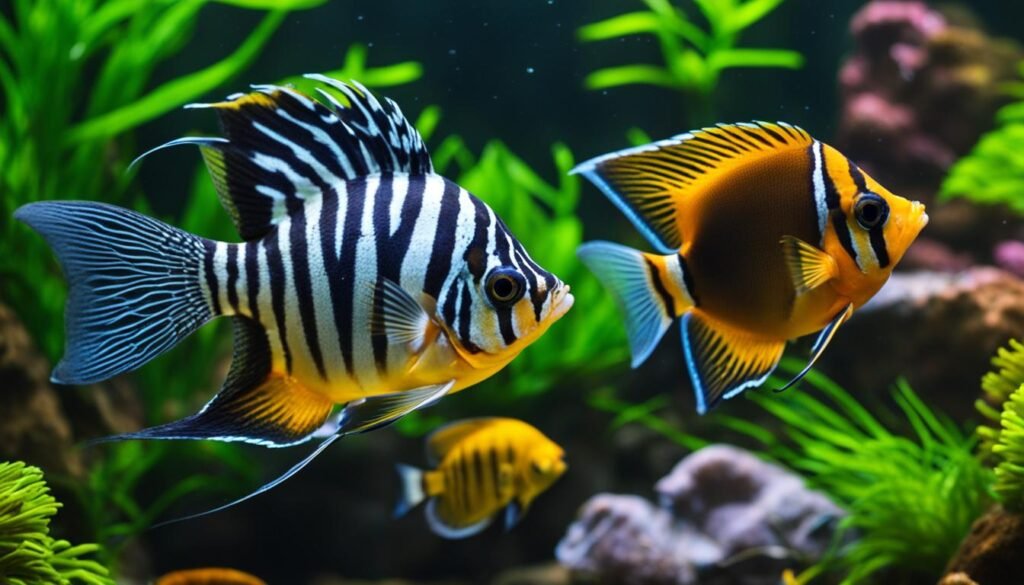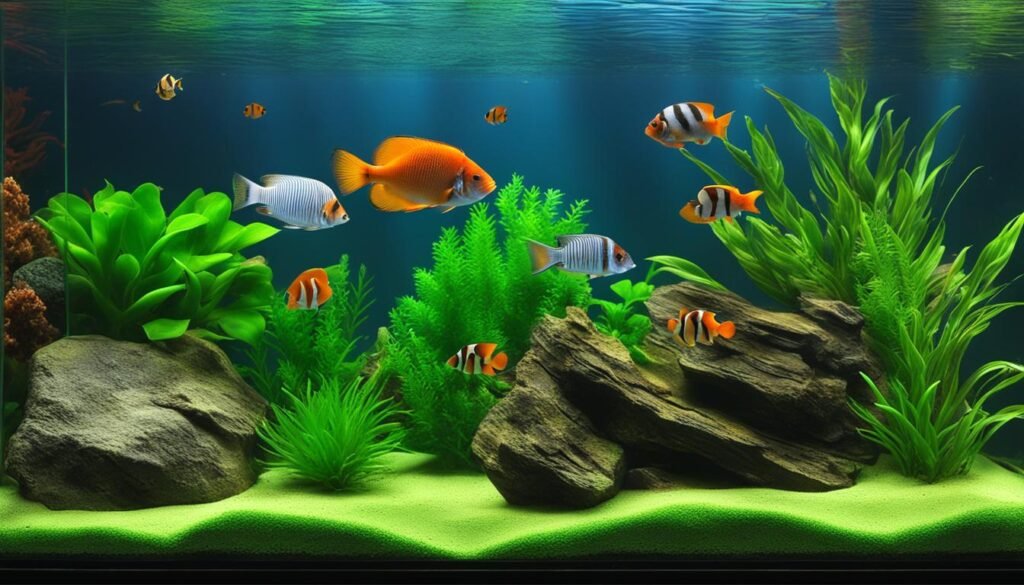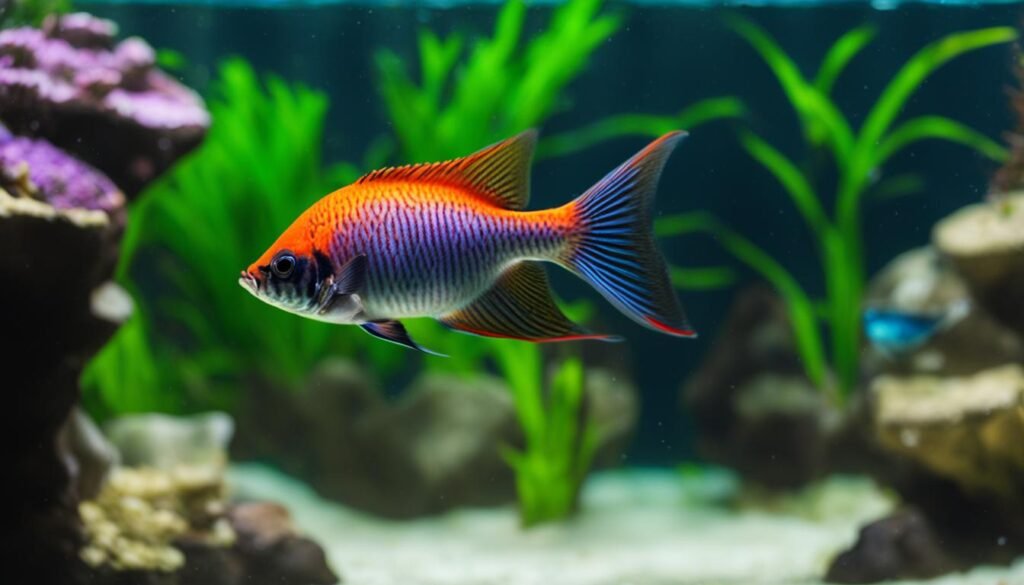Your cart is currently empty!

Are Tiger Barbs Compatible With Angel Fish? Uncover the Facts.
When it comes to creating a vibrant and harmonious community tank, compatibility between different fish species is crucial. One popular pairing that often raises questions is the compatibility of Tiger Barbs and Angel Fish. Are these two species able to coexist peacefully in the same tank? Let’s dive into the facts and find out.
Tiger Barbs are known for their semi-aggressive nature and fin-nipping behavior, which can make them potentially incompatible with many fish species, including Angel Fish. However, with proper care and consideration, it is possible to maintain these two species together in the same tank and enjoy their unique beauty and behavior.
To achieve successful coexistence, it is important to understand the behavior, temperament, and tank requirements of both Tiger Barbs and Angel Fish. By taking the necessary steps to create a suitable environment and selecting compatible tank mates, you can increase the chances of a peaceful and thriving community tank.
Key Takeaways:
- Tiger Barbs and Angel Fish can potentially live together in the same tank with proper care and consideration.
- Understanding the behavior and temperament of both species is crucial for successful coexistence.
- Tiger Barbs are semi-aggressive fish known for fin-nipping, while Angel Fish are generally peaceful.
- Size compatibility, competition for food, and water parameters are important factors to consider when selecting tank mates.
- Avoid pairing Tiger Barbs with slow-moving, long-finned, or smaller fish to minimize aggression.
Choosing Tank Mates – What You Need to Know
When it comes to selecting tank mates for Tiger Barbs, there are a few key considerations to keep in mind. Finding compatible fish species is crucial to ensure a harmonious community tank. So, let’s dive into what you need to know about choosing the right tank mates for your Tiger Barbs.
Temperament
Tiger Barbs are known for their sem-aggressive nature and fin-nipping behavior. As such, it’s important to avoid pairing them with slow-moving or long-finned fish that may become easy targets. Look for fish species with a peaceful temperament that can tolerate the occasional sparring from Tiger Barbs.
Size
Considering the size compatibility of your tank mates is essential. Tiger Barbs typically grow to around 2-3 inches, while Angel Fish can reach sizes of 3-4 inches. It’s best to choose fish species that are similar in size to avoid potential aggression or predation.
Competition
Tiger Barbs are voracious eaters and can be quite competitive when it comes to food. To ensure all your tank mates are well-fed and stress-free, opt for fish species that have a similar feeding style and can withstand the competitive nature of Tiger Barbs.
By taking into account the temperament, size, and competition for food, you can make informed decisions when selecting tank mates for your Tiger Barbs. Finding suitable companions will create a cohesive and visually appealing community tank.
Temperament

Understanding the temperament of Tiger Barbs and Angel Fish is crucial when considering their compatibility. Tiger Barbs are known for their territorial aggression and fin-nipping behavior. They can be quite aggressive towards slow-moving or long-finned fish, potentially causing stress and harm. On the other hand, Angel Fish are generally peaceful in nature. However, they can become aggressive if provoked or feel their territory is being invaded.
The contrasting temperaments of Tiger Barbs and Angel Fish make them potentially incompatible tank mates. The aggressive nature of Tiger Barbs can disrupt the peaceful environment that Angel Fish prefer. It is important to consider the temperament of both species before deciding to keep them together in the same tank.
Compatibility based on temperament:
- Tiger Barbs: Semi-aggressive, fin-nipping behavior
- Angel Fish: Generally peaceful, but can become aggressive if provoked
It is essential to create a harmonious environment that meets the needs of both species. Providing ample hiding spaces, territories, and visual barriers can help minimize aggression and promote peaceful coexistence. Regular monitoring of their behavior and interactions is also crucial to ensure the well-being of both Tiger Barbs and Angel Fish in the tank.
Size
Tiger Barbs typically grow to around 2-3 inches in length, while Angel Fish can reach sizes of 3-4 inches. Considering the size compatibility of tank mates is crucial for a successful community tank. The size difference between Tiger Barbs and Angel Fish can lead to potential aggression or predation, with Tiger Barbs being more likely to target smaller fish. It’s important to choose tank mates that are similar in size to create a balanced and harmonious environment.
Compatible Tank Mates Based on Size:
- Rasboras – Similar in size and peaceful demeanor.
- Corydoras Catfish – Bottom-dwelling fish that won’t compete for territory.
- Dwarf Gouramis – Similar in size and known for their peaceful nature.
- Harlequin Rasboras – Peaceful fish that are similar in size to Tiger Barbs.
- Platies – Colorful and peaceful fish that can coexist with Tiger Barbs.
By choosing tank mates that are similar in size to Tiger Barbs, you can minimize the risk of aggression and ensure a harmonious community tank. It’s important to monitor the interactions between the fish and be prepared to make adjustments if any signs of aggression or stress occur.
Creating a balanced tank environment takes careful consideration of factors such as temperament, size, and compatibility. By understanding the size differences between Tiger Barbs and Angel Fish, you can make informed decisions when selecting tank mates and help prevent potential aggression or predation. Remember to always provide sufficient space and hiding spots for all fish to reduce stress and promote a healthy community tank.
Tiger Barbs and Angel Fish Feeding Behavior: Understanding Competition in a Community Tank

In a community tank, competition for food among different fish species is a common occurrence. When it comes to Tiger Barbs and Angel Fish, their feeding behavior plays a crucial role in determining their compatibility. Tiger Barbs are known for their voracious appetite and can outcompete other fish for food. Their aggressive feeding style can leave slower or more passive fish hungry and stressed. On the other hand, Angel Fish typically have a more gentle feeding style. They may take their time to eat and may not be as assertive when it comes to claiming their share of food.
To ensure compatibility based on competition for food, it is essential to consider these factors:
- Feeding Habits: While Tiger Barbs may gobble up food quickly, Angel Fish may require more time and patience. It is important to choose tank mates with similar feeding habits to minimize competition and ensure that all fish have access to sufficient food.
- Food Distribution: To prevent food from being monopolized by one species, consider using feeding techniques such as feeding rings or multiple feeding stations. This can help distribute food throughout the tank, allowing each fish to have a fair chance at a satisfying meal.
- Food Variety: Offering a varied diet can also help alleviate competition for food. Providing a mix of flakes, pellets, frozen or live foods can cater to the different dietary preferences of Tiger Barbs and Angel Fish, reducing the chances of aggression during feeding time.
By understanding the feeding behavior of Tiger Barbs and Angel Fish and taking appropriate measures to address competition for food, it is possible to maintain a harmonious and stress-free community tank.
Finding the Right Balance
Creating a balanced feeding environment in a community tank requires observation and adjustment. Monitoring the feeding dynamics among the tank mates can help identify any signs of aggression or dominance during feeding time. If necessary, consider making changes such as increasing the number of feeding stations, adjusting the feeding schedule, or even separating fish that are consistently aggressive.
Remember, each fish has its own unique personality and tendencies, so compatibility can vary even within the same species. It is crucial to closely monitor the behavior and health of all tank mates to ensure their well-being and reduce any potential conflicts.
By understanding the competition for food in a community tank and implementing strategies to promote harmony, you can create a thriving ecosystem where Tiger Barbs and Angel Fish can coexist peacefully.
Tank Parameters and Ideal Tank Setup for Tiger Barbs and Angel Fish

Creating the ideal tank environment for Tiger Barbs and Angel Fish requires careful attention to their specific tank parameters. These parameters include water pH, water hardness, and temperature, all of which play a crucial role in maintaining the health and compatibility of these two species.
Water Parameters:
- Tiger Barbs thrive in a pH range of 6.0-7.0 and water hardness of 5-19 dGH.
- Angel Fish prefer a pH range of 6.8-7.8 and water hardness of 4-12 dGH.
To create a suitable tank environment, it is recommended to maintain a pH level that falls within the overlapping range for both species, ideally around 7.0. The water hardness should be kept between 5-12 dGH, providing a compromise between the preferred values of Tiger Barbs and Angel Fish.
Temperature:
The temperature range for Tiger Barbs is 75-80 degrees Fahrenheit, while Angel Fish prefer a slightly warmer range of 78-84 degrees Fahrenheit. To accommodate both species, a temperature of around 78 degrees Fahrenheit is ideal.
When setting up the tank, consider the size and filtration system. Tiger Barbs and Angel Fish require a minimum tank size of 30 gallons to provide ample swimming space. A well-maintained filtration system is essential to maintain water quality and ensure the removal of any waste or toxins.
Additionally, it is recommended to create a tank setup that includes plenty of hiding spots and areas where the fish can establish their territories. Aquatic plants, driftwood, and rocks can be used to create a natural environment and provide shelter for the fish. Regular water changes and proper maintenance will help keep the tank parameters stable and create an ideal habitat for both Tiger Barbs and Angel Fish.
Incompatible Tank Mates for Tiger Barbs

When considering tank mates for Tiger Barbs, it is important to be aware of fish species that may not be compatible with their semi-aggressive nature. To ensure a peaceful and harmonious community tank, here are some fish species to avoid pairing with Tiger Barbs:
- Guppies: Guppies have long, flowing fins that can easily become targets for the fin-nipping behavior of Tiger Barbs. They are also generally peaceful and may not be able to defend themselves against the more aggressive Tiger Barbs.
- Goldfish: Goldfish are slow-moving and have delicate fins, making them vulnerable to the fin-nipping tendencies of Tiger Barbs. Additionally, Goldfish have different temperature and water parameter requirements, which may not be compatible with Tiger Barbs.
- Bettas: Bettas, also known as Siamese Fighting Fish, are known for their aggressive nature. Pairing them with Tiger Barbs, who are also semi-aggressive, can lead to increased aggression and stress for both species.
Overall, it is important to select tank mates that can tolerate the behavior of Tiger Barbs and have a similar temperament. Tolerant, active, and robust fish species are more likely to thrive in a community tank with Tiger Barbs.
Community Tank Setup

Setting up a community tank for Tiger Barbs and Angel Fish requires careful consideration to ensure the well-being and compatibility of both species. Here are some key factors to consider:
Tank Size:
Providing a spacious environment is crucial for the comfort and territorial needs of both Tiger Barbs and Angel Fish. A minimum tank size of 30 gallons is recommended to accommodate their active swimming and establish territories. This will help minimize aggression and maintain a harmonious community tank.
Filtration:
Effective filtration is essential for maintaining optimal water quality in a community tank. Both Tiger Barbs and Angel Fish are sensitive to changes in water parameters, and a high-quality filter will help remove waste, excess nutrients, and maintain stable ammonia and nitrate levels. Consider a filter suitable for the size of your tank and ensure regular maintenance to keep the water clean and healthy.
Water Parameters:
Creating a suitable environment with consistent water parameters is crucial for the well-being of Tiger Barbs and Angel Fish. Aim for a pH range of 6.8-7.4, a temperature of 75-82 degrees Fahrenheit, and moderate water hardness (6-12 dGH) to ensure optimal health and reduce stress levels. Regular water testing and appropriate adjustments are necessary to maintain a stable and favorable aquatic environment.
Aquatic Plants and Decorations:
Adding live aquatic plants and suitable decorations can enhance the natural habitat of Tiger Barbs and Angel Fish, providing hiding spots, territory boundaries, and enrichment. Dense vegetation like java moss, floating plants, and driftwood can help create hiding places and break line of sight, minimizing aggression and promoting a sense of security for both species.
Where to Buy Compatible Tank Mates for Tiger Barbs
When it comes to purchasing suitable tank mates for your Tiger Barbs, it’s important to source them from reputable aquarium stores or online retailers specializing in freshwater fish. These trusted sources can provide you with a wide variety of fish species that are known to coexist well with Tiger Barbs.
By purchasing from reputable sellers, you can ensure that the fish you introduce to your Tiger Barb tank are healthy, properly quarantined, and suitable for the tank size and water parameters. This will greatly increase the chances of successful cohabitation and reduce the risk of introducing any diseases or aggressive individuals.
When looking for compatible tank mates, consider the specific needs and temperament of your Tiger Barbs. It’s also important to take into account the size and behavior of the potential tank mates. By doing thorough research and consulting with knowledgeable professionals, you can find the best fish species that will thrive alongside your Tiger Barbs, creating a vibrant and harmonious community tank.
15 Best Tank Mates For Tiger Barbs
Tiger Barbs can be quite territorial and aggressive, so it’s important to choose tank mates that can coexist peacefully with them. Here are 15 fish species that are known to be compatible with Tiger Barbs and can provide a harmonious community tank:
1. Rosy Barbs (Pethia conchonius)
Rosy Barbs are similar in size and temperament to Tiger Barbs, making them great tank mates. They have vibrant colors and add a beautiful contrast to your tank.
2. Silver Dollars (Metynnis spp.)
Silver Dollars are peaceful fish that can tolerate the fast-paced swimming of Tiger Barbs. They are known for their silver body with a distinctive round shape.
3. Corydoras Catfish (Corydoras spp.)
Corydoras Catfish are bottom-dwellers that can peacefully coexist with Tiger Barbs. They help keep the tank clean by scavenging for leftover food and debris.
4. Bristlenose Plecos (Ancistrus spp.)
Bristlenose Plecos are great tank mates for Tiger Barbs, as they are peaceful and help control algae growth in the tank. They have a unique appearance with their bristle-like appendages.
5. Black Skirt Tetras (Gymnocorymbus ternetzi)
Black Skirt Tetras are known for their peaceful nature and can withstand the fin-nipping behavior of Tiger Barbs. They have a black body with long flowing fins.
6. Harlequin Rasboras (Trigonostigma heteromorpha)
Harlequin Rasboras are peaceful and have a similar temperament to Tiger Barbs. They have striking orange and black patterns on their body.
7. Swordtails (Xiphophorus hellerii)
Swordtails are peaceful fish that can coexist with Tiger Barbs. They are known for their elongated fin, resembling a sword.
8. Rainbowfish (Melanotaenia spp.)
Rainbowfish are vibrant and peaceful fish that can tolerate the aggression of Tiger Barbs. They come in a variety of colors, adding a stunning display to your tank.
9. Gouramis (Trichogaster spp.)
Gouramis are peaceful and can coexist with Tiger Barbs. They have a labyrinth organ that allows them to breathe air from the water’s surface.
10. Kuhli Loaches (Pangio kuhlii)
Kuhli Loaches are bottom-dwelling fish that can peacefully live with Tiger Barbs. They have a unique eel-like appearance and are known for their playful nature.
11. Cherry Barbs (Puntius titteya)
Cherry Barbs are peaceful and have a similar size and temperament to Tiger Barbs. They have a vibrant red body that adds color to your tank.
12. Danios (Danio rerio)
Danios are active and fast-swimming fish that can keep up with the energetic Tiger Barbs. They have a distinctive striped pattern on their body.
13. White Cloud Mountain Minnows (Tanichthys albonubes)
White Cloud Mountain Minnows are peaceful fish that can tolerate the aggression of Tiger Barbs. They have a shimmering silver body with a red-tipped tail.
14. Neon Tetras (Paracheirodon innesi)
Neon Tetras are small and peaceful fish that can coexist with Tiger Barbs. They have a vibrant blue and red stripe running along their body.
15. Zebra Danios (Danio rerio)
Zebra Danios are fast and energetic fish that can keep up with the active Tiger Barbs. They have distinct zebra-like stripes, hence their name.
When introducing new fish to your tank, it’s important to monitor their interactions and ensure that everyone is getting along. Always provide enough hiding spots and ample space for each fish to establish their territory. By selecting compatible tank mates and creating a suitable environment, you can enjoy a beautiful and peaceful community tank with your Tiger Barbs.
Closing Thoughts
In conclusion, keeping Tiger Barbs and Angel Fish together in the same tank is possible but requires careful consideration. The contrasting temperaments of the two species, with Tiger Barbs being semi-aggressive and Angel Fish generally peaceful, can create challenges for compatibility. Additionally, their size difference and competition for food must be taken into account when selecting tank mates.
When maintaining Tiger Barbs and Angel Fish in the same tank, it is crucial to choose compatible tank mates that can tolerate the fin-nipping behavior of Tiger Barbs. Avoid pairing them with slow-moving, long-finned, or smaller fish that may become targets of aggression. By selecting fish species that have similar temperaments, size, and feeding habits, you can create a harmonious and stress-free environment for all the inhabitants of your tank.
To ensure successful coexistence, it is essential to provide a well-maintained tank setup with appropriate water parameters for both Tiger Barbs and Angel Fish. Regular monitoring of their interactions and behavior is crucial to identify any signs of aggression or stress. With proper care, attention, and a well-thought-out approach, you can enjoy the beauty and dynamic nature of both Tiger Barbs and Angel Fish in the same tank.
FAQ
Are Tiger Barbs compatible with Angel Fish?
Tiger Barbs are semi-aggressive and known for fin nipping, making them potentially incompatible with Angel Fish. However, with proper care and consideration, it is possible to keep them together in the same tank.
What should I consider when choosing tank mates for Tiger Barbs?
When choosing tank mates for Tiger Barbs, consider their temperament, size, competition for food, and tank parameters. Look for fish species that are similar in size and have a peaceful demeanor.
What are the temperaments of Tiger Barbs and Angel Fish?
Tiger Barbs are semi-aggressive and known for their territorial aggression and fin-nipping behavior. Angel Fish are generally peaceful but can become aggressive if provoked. Their contrasting temperaments make them potentially incompatible tank mates.
Do size differences between Tiger Barbs and Angel Fish matter?
Yes, size differences can lead to potential aggression or predation. Tiger Barbs are more likely to target smaller fish. Consider the size compatibility of tank mates for a successful community tank.
Do Tiger Barbs and Angel Fish have different feeding behaviors?
Tiger Barbs are voracious eaters and can outcompete other fish for food. Their aggressive feeding behavior can leave tank mates hungry or stressed. Angel Fish may have a more passive feeding style. Ensure all fish have access to sufficient food.
What tank parameters should I consider for Tiger Barbs and Angel Fish?
Tiger Barbs thrive in a pH range of 6.0-7.0, water hardness of 5-19 dGH, and a temperature range of 75-80 degrees Fahrenheit. Angel Fish prefer a pH range of 6.8-7.8, water hardness of 4-12 dGH, and a temperature range of 78-84 degrees Fahrenheit. Ensure suitable water parameters for both species.
What fish species should I avoid pairing with Tiger Barbs?
Avoid pairing Tiger Barbs with slow-moving, long-finned, or smaller fish. Some examples are Guppies, Goldfish, Bettas, and other delicate or peaceful species. Consider the compatibility and behavior of potential tank mates.
How do I set up a community tank for Tiger Barbs and Angel Fish?
Use a minimum tank size of 30 gallons, provide proper filtration and regular maintenance, and add aquatic plants and decorations for hiding spots. Ensure a suitable tank setup for both species.
Where can I buy compatible tank mates for Tiger Barbs?
Visit reputable aquarium stores or online retailers specializing in freshwater fish. Ensure the fish are healthy, properly quarantined, and suitable for your tank.
What are some compatible tank mates for Tiger Barbs?
Here are 15 fish species known to be compatible: [List the fish species here]
Can Tiger Barbs and Angel Fish live together?
Yes, it is possible to keep Tiger Barbs and Angel Fish together in the same tank with proper care and consideration. Understanding their behavior, temperament, and tank requirements is essential for successful coexistence.
Leave a Reply